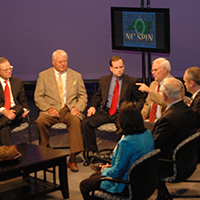Like many of its Southern neighbors, much of North Carolina’s economic base in the 20th century evolved from agriculture to manufacturing. Textiles and furniture plants, in particular, employed thousands of workers from the mountains to the coast.
It was tough work in hot, dusty plants – even as recently as the 1980s. But people with little education or means could find long-term employment and carve out lives for themselves and their families. Generations of weavers and machinists made their way through factories with names like Cannon Mills, Hanes, Thomasville Furniture and Barcalounger.
Those days and jobs are mostly gone. The economic boon in today’s North Carolina lies in the banking center of Charlotte; the pharmaceutical plants and software developers of Research Triangle Park; and the renowned university centers and health care offerings of Raleigh, Durham and Chapel Hill.
But while those white-collar industries thrive, where is North Carolina’s blue-collar working class? Textile mills and furniture factories left U.S. shores decades ago. The competition for new manufacturers is fierce. It isn’t so easy to land a giant automaker or tire plant, you know.
Or is it?
While North Carolina has struggled to compete with other states for blue-chip industries, our neighbor just south of the border has done pretty well. South Carolina has put together resources and incentives packages to land BMW, Boeing and, just recently, Volvo. Not only are those jobs every state would love to have; they bring with them a built-in need for suppliers and other support industries. South Carolina also happens to be the largest tire manufacturer in the country now.
The Palmetto State didn’t land those plums overnight. Economic developers and state leaders have put together a steady, sustained growth during the past 25 years. North Carolina’s reputation for banks, health care and research is a star. But it certainly would be nice to land some companies with jobs that working class folks can build their lives around.







